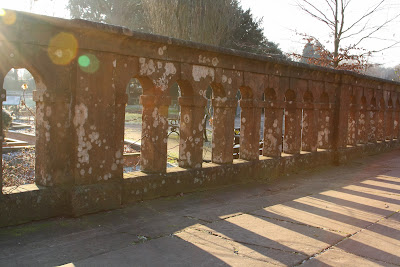This exercise looks at “improving” a conventional landscape image in a variety of ways:
1. Taking two images (one exposed for the sky and one for the land) and combining the two using Photoshop to erase the overexposed sky, leaving behind the sky with the correct exposure.
2. Taking two images (one exposed for the sky and one for the land), combined the two using Photoshop then cut out the sky to reveal the well exposed sky and landscape.
3. Combining the same two images in a HDR software (included in Photoshop CS3)
4. Combining the two images using blending software in Photoshop CS3.
5. Taking the sky from another image and adding into the original landscape exposure image and blending the image together.
Original
 |
| Optimized sky |
 |
| Optimized landscape |
 |
| Tippings wood addition 1 erased sky |
To achieve this image, I cut and pasted the image with overexposed sky onto the correctly exposed sky. Using the erase tool, I rubbed out the overexposed sky, leaving behind one correctly exposed image.
Is this acceptable?
When viewed at 100%, the mist rising up from the trees is still visible, although there is a dark line where I have used a soft brush to soften the join between the two images. As a first attempt, I thought this looked acceptable. It took patience and for me the issue of how much time I would like to spend editing an image was raised.
Image 2
 |
| Tippings Wood addition 2 cut out sky |
This was achieved by pasting the image with an overexposed sky on top of the correctly exposed sky and refining the edges.
Is this acceptable?
At 100%, the trees in the background, appear as an overexposed distracting line. I Thought this way of combining the images did not work so well. It was quicker, but not as effective.
Image 3
 |
| HDR in Photoshop CS3 software |
I combined two images using the HDR software in CS3.
Is this acceptable?
After setting up the images, the computer produced a version which was unacceptable to me. The sky has a large area of burnout. The field and gate were ok. I could in future try combining more images of different exposures rather than just two (although I did not take them on this occasion).
Image 4
 |
| Combined using blending software Photoshop CS3 |
Following Gulbins and Steinmueller (2011) P256 instruction on blending images, I used the following method to achieve the above image:
> Select, copy and paste the correctly exposed sky image onto the overexposed sky image
> Select > colour range to select the sky > set fuzziness > ok
> Select refine edge > set feathering of pixels > view in different versions
> Flatten image
Is this acceptable?
At 100% this looks ok. Once I understood the process, I thought this was quite easy to do and very similar to version 1 (using the eraser tool), but less time consuming.
Image 5
 |
| Sky |
 |
| Sky added from another image |
I started off trying to add a smaller piece of sky and found gaps in the photo with no pixels. I decided this was the time to start creating a bank of skies. Using my first complete image of sky, I was able to add the landscape as a layer behind the sky using an on line tutorial from Patterson (accessed 22/12/13).
This method involved making a mask and using sliders to blend in the sky. After having done this a few times to perfect my initial attempt, I was fairly pleased with the result. I think it may be easier to use a graphics tablet rather than the pad on my laptop as there are a couple of areas such as around the tree when viewed at 100% where it is not quite perfect. I considered the colour of the sky, although this can be adjusted before adding using curves, and the amount of blending is to my taste.
Conclusion
I had not explored the world of altering images in this way, although I have several colleagues who enjoy manipulation similar to this and who have shared their experiences with me. I had previously thought that Photoshop’s software held the key to HDR photography, and this exercise challenged that belief. I was disappointed with my result. I think the best results I had were with the blending two images (image 4) and changing the sky (image 5). As for whether it is legitimate to alter a photograph in this way; I think it is acceptable to enhance an image providing considerations are taken into account such as direction of the sun, shadows, reflections, are taken into account, especially if the sky is dull and lacks interest. The experience of viewing the photograph has to be believable.
Bibliography
http://www.photoshopessentials.com/photo-editing/replace-sky/ accessed 22/12/13
Gulbins. J, Steinmueller. U, (2011) The Digital Photography Workflow Handbook, Rocky Nook, CA






